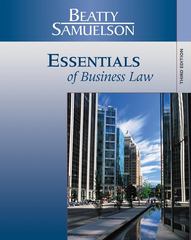Question
Please explain the following 14. Autobots Bottling purchased for P800,000 a trademark for a very successful soft drink it markets under the name OK!. The
Please explain the following
14. Autobots Bottling purchased for P800,000 a trademark
for a very successful soft drink it markets under the
name OK!. The trademark was determined to have an
indefinite life. A competitor recently introduced a
product that is in direct competition with the OK!
product, thus suggesting the need for an impairment
test. Data gathered by Autobots suggests that the
useful life of the trademark is still indefinite, but the
cash flows expected to be generated by the trademark
have been reduced either to P30,000 per year (with a
probability of 80%) or to P60,000 per year (with 20%
probability). The appropriate risk-free interest rate is
5%. The appropriate risk-adjusted interest rate is
10%.
The loss on impairment of trademark is?
15. When deciding on the discount rate that should be
used, which factors should be taken into account?
a. Pretax rates
b. The time value of money
c. Risks that relate to the asset for which future cash
flow estimates have not been adjusted
d. All of these.
16. When calculating the estimates of future cash flows,
which of the following cash flows should not be
included?
a. Cash flows from the sale of assets produced by the
asset
b. Cash outflows on the maintenance of the asset
c. Cash flows from disposal
d. Income tax payment
17. An entity has an oil platform in the sea. The entity has
to decommission the platform at the end of its useful
life, and a provision was set up at the commencement
of production. The carrying amount of the provision is
P8 million. The entity has received an offer of P20
million (selling costs P1 million) for the rights to the oil
platform, which reflects the fact that the owners have
to decommission it at the end of its useful life. The
value-in-use of the oil platform is P26 million ignoring
decommissioning costs. The current carrying amount
of the oil platform is P28 million. How much should be
recognized as impairment loss?
18. The recoverable amount of asset to be disposed of is
a. Fair value less costs of disposal
b. Value in use
c. The higher of a and b
d. The lower of a and b
Use the following information for the next two questions.
An entity has a building classified as investment property.
The building was acquired on January 1, 2016 at a cost of
P50,000,000. The building has an estimated life of 25
years and nil residual value. The following information is
available:
12/31/19 12/31/20
Fair value P45,000,000 P42,000,000
Costs of disposal 4,000,000 3,500,000
Value in use 43,000,000 39,500,000
19. If the entity used the cost model, the total expense to
be recognized in 2020 profit or loss is?
20. If the entity used the fair value model instead of cost
model, the 2020 profit would have been
a. The same c. Lower by P1,000,000
b. Higher by P500,000 d. Lower by P500,000
Use the following information for the next three questions.
An entity is developing a new production process. During
2019, expenditure incurred was P1,000,000, of which
P900,000 was incurred before 1 December 2019 and
P100,000 was incurred between 1 December 2019 and 31
December 2019. The entity is able to demonstrate that, at
1 December 2019, the production process met the criteria
for recognition as an intangible asset. The recoverable
amount of the know-how embodied in the process
(including future cash outflows to complete the process
before it is available for use) is estimated to be P500,000.
During 2020, expenditure incurred is P2,000,000. At the
end of 2020, the recoverable amount of the know-how
embodied in the process (including future cash outflows to
complete the process before it is available for use) is
estimated to be P1,900,000.
21. The impairment loss to be recognized in 2019 is?
22. The impairment loss to be recognized in 2020 is?
23. The intangible asset shall be tested for impairment
a. Annually, if there is any indication of impairment.
b. Annually, irrespective of whether there is any
indication of impairment.
c. Annually, irrespective of whether there is any
indication of impairment when the asset is already
available for use.
d. The intangible asset is not subject to impairment
since it is not yet available for use.
24. Which statement is incorrect regarding recognition and
measurement of an impairment loss?
a. An impairment loss shall be recognized
immediately in profit or loss, unless the asset is
carried at revalued amount in accordance with
another Standard.
b. Any impairment loss of a revalued asset shall be
treated as a revaluation decrease in accordance
with that other Standard.
c. After the recognition of an impairment loss, the
depreciation (amortization) charge for the asset
shall be adjusted in future periods to allocate the
asset's revised carrying amount, less its residual
value (if any), on a systematic basis over its
remaining useful life.
d. None of these.
25. Skipton Co. bought land in 2011 at a cost of P300,000.
In 2014 the land was revalued to P350,000 and in
2019 it was revalued again to P400,000. At the end of
2020 the land had a value in use of P270,000 and the
fair value less costs of disposal was P285,000.
How much of the impairment loss should be recognized
in 2020 profit or loss?
Step by Step Solution
There are 3 Steps involved in it
Step: 1

Get Instant Access to Expert-Tailored Solutions
See step-by-step solutions with expert insights and AI powered tools for academic success
Step: 2

Step: 3

Ace Your Homework with AI
Get the answers you need in no time with our AI-driven, step-by-step assistance
Get Started


